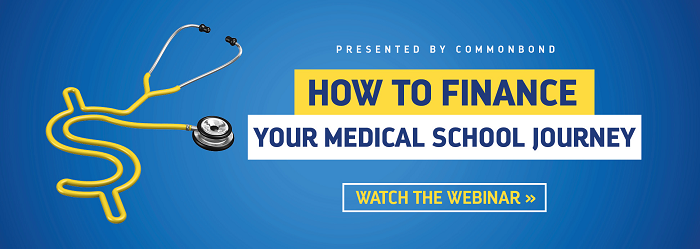

So you’re nearing the end of medical school and you’ve got mountains of debt, but don’t know how best to maximize savings and keep your financial picture healthy. CommonBond is here to help break down some common terms and show you how to save thousands on your student loans.
1. Grace Period
What is the grace period? For student loans, the grace period typically refers to the six months following graduation during which you do not need to make any payments on your student loans. At the end of this grace period, you will begin making regular monthly payments on your loans.
What happens during the grace period? For many loans, interest is still accruing during your grace period, but you are not required to make any payments at all. This means that when the six months of the grace period are over, six months’ worth of interest will capitalize, and your monthly payments will reflect this larger loan balance. Many lenders allow you to make payments during your grace period to reduce the added cost of capitalized interest.
If you want to lower your interest rate through refinancing while in your grace period, many lenders require that you begin making payments even if the six months are not over. A handful of lenders, including CommonBond, honor your grace period so that you can refinance to a better rate and still wait to begin repayment.
What should I do if my grace period is ending? First, gather the basic information on all your student loans, including how many student loans will enter repayment and when, your account numbers, your current monthly payment schedule, and your loan servicer’s contact information. You can generally find all of that information by looking at your student loan monthly statements or by logging into your student loan servicer portal. Then, evaluate whether your loans are really the best fit for your personal situation. If you might benefit from lower interest rates, a different loan term or more flexible monthly payments, student loan refinancing may be right for you.
<< Upcoming webinar: How to Finance Your Medical School Journey. Register now! >>
2. Deferment
What is deferment? A deferment is a period during which you do not make payments on your student loans. There are typically two types of deferment: in-school deferment and deferment for six months after graduation which, as mentioned earlier, is referred to as your grace period.
What happens during in-school deferment? In-school deferment happens when you borrow money to pay for school, but you do not make any monthly payments on this loan until you graduate. For most loans, interest will continue to accrue during in-school deferment and then capitalize, adding to the loan balance you must begin repaying six months after graduation. Only special federal student loans – such as the Perkins Loan – allow for in-school deferment with no accruing interest.
What happens during deferment after I graduate? Because deferment is a form of borrower protection that lenders offer at their discretion, your deferment options will be different with each lender, so contact your loan servicer to learn about your eligibility for deferment options. At CommonBond, deferment after graduation comes in two forms: a six-month grace period directly following graduation and a deferment period because you’ve gone back to earn a graduate degree. You do not need to make loan payments in either of these cases, though interest will continue to accrue.
3. Forbearance
What is forbearance? Like deferment, forbearance is a period of time during which you do not need to make payments on your student loans. Unlike deferment, borrowers must apply to their lenders to enter forbearance and often do so in the case of economic hardship.
What happens during forbearance? Forbearance is a type of borrower protection, a feature that each lender defines differently for their specific loans. Therefore, forbearance could involve temporarily reducing payments or simply postponing them, depending on the loan. Your lender will also specify for how long you can be in forbearance and the timing around when you need to apply for forbearance. Interest continues to accrue on most loans during forbearance and will capitalize at the end of the period, adding to the loan balance you’ll need to repay.
How is forbearance different from deferment? The main difference between deferment and forbearance is that you’re automatically granted a deferment, but you must apply for forbearance.
What should I do if I think I need forbearance? First, contact your loan servicer as soon as you think you’ll have trouble making payments. They can explain all your options and how forbearance will affect your loan. Acting early is important because you’ll have to apply for forbearance. Since you can’t enter forbearance without approval from your lender, seeking advice as early as possible will ensure you’re not forced to miss a payment.
4. Public Service Loan Forgiveness
What is Public Service Loan Forgiveness? Public Service Loan Forgiveness means that after working 10 years in certain public service jobs, you can have the remaining balance of your federal student loans forgiven. We’ll walk you through what jobs are eligible for this type of loan forgiveness, what federal loans can be forgiven under this program, when those loans can be forgiven, and how to apply for the program.
What jobs are eligible? You’re automatically eligible for Public Service Loan Forgiveness if you work at a federal, state or local government agency or a not-for-profit organization that has been designated as tax-exempt by the Internal Revenue Service under Section 501(c)(3) of the Internal Revenue Code. If you work for this kind of organization, the nature of your employment or the service you provide them doesn’t matter.
You also may be eligible if you work for a private, not-for-profit employer that is not a tax-exempt organization if it provides certain specified public services. These services in the medical field include:
• Emergency management
• Military service
• Public service for individuals with disabilities and the elderly
• Public health (including nurses, nurse practitioners, nurses in a clinical setting, and full-time professionals engaged in health care practitioner occupations and health care support occupations)
• Public education
Employees of labor unions or partisan political organizations are not eligible for federal loan forgiveness under this program.
What kinds of loans are eligible? Only federal Direct Loans are eligible. Federal Family Education Loans (FFEL), which have not been dispersed since June 2010, and Perkins Loans, for students with exceptional financial need, are not eligible for Public Service Loan Forgiveness. You can consolidate FFEL and Perkins loans into a Direct Loan to take advantage of Public Service Loan Forgiveness, but only payments made toward the Direct Loan after consolidation count toward loan forgiveness. Loans through private lenders are not eligible for Public Service Loan Forgiveness.
When can my federal student loans be forgiven? You must have made 120 payments, or 12 payments for 10 years, on time and in full, on your Direct Loans. Only payments made after October 1, 2007, are eligible. At the end of the 10-year period, any remaining balance on your loans will be forgiven, or erased. To take full advantage of Public Service Loan Forgiveness, you should be on an income-driven repayment plan so that you pay as little as possible during this time. Why? If you had a standard 10-year repayment plan and made 10 years of standard repayments, you would have no remaining balance to forgive at the end of 10 years.
How do I apply for Public Service Loan Forgiveness? The earliest any federal student loan borrower will be able to qualify for Public Service Loan Forgiveness is October 2017. Therefore, there is no application for forgiveness yet. The application will be released closer to the time when the first borrowers will qualify for forgiveness. However, you can complete the Public Service Loan Forgiveness: Employment Certification Form to have the Department of Education determine whether your employment qualifies for the program.
<< Save your spot at our upcoming webinar: How to Finance Your Medical School Journey! >>
5. Student Loan Refinancing
What is student loan refinancing? If you don’t work for a non-profit employer and thus don’t plan to take advantage of Public Service Loan Forgiveness, student loan refinancing may be the best option for you to save on your student loans. When you refinance, you take out a new loan to pay off your old loan(s). Some reasons for refinancing include: To get a lower interest rate, to decrease monthly payments or to switch from a fixed rate loan to a variable rate loan or vice versa.
CommonBond can refinance federal, private and previously consolidated loans.
How do I know if I’m eligible to refinance my loans? It’s as easy as 1-2-3:
1. You have to be a U.S. citizen or permanent resident. That means if you are an international student, we are not (currently) able to lend to you, but we are working to change that.
2. You must have graduated from one of the schools in our eligible network. Our network has expanded to more than 2,000 Title IV accredited universities or graduate programs.
3. CommonBond considers your credit history and other credit factors and will quickly make a decision on your application.
How do I apply for refinancing with CommonBond? Visit CommonBond to fill out our quick and easy online application. You can see all of your estimated rates through a soft credit pull, which does not negatively impact your credit, and there is no obligation to move forward after you see your estimates.
Want to learn more? Be sure to attend the webinar How to Finance Your Medical School Journey presented by CommonBond on Tuesday, November 14th, at 4:00PM PST.
Caryn Ganeles is the Manager of Business Development at CommonBond and has been helping borrowers solve their student loan issues for over two and a half years. She received her B.S. in Communication from Cornell University. As Accepted’s dedicated account manager, Caryn is happy to answer any questions that you have by reaching out to her directly at caryng@commonbond.co.
Radhika Duggal, Vice President of Marketing for CommonBond, is a marketing leader with extensive experience in highly regulated industries like healthcare and financial services. Throughout her career, she has led the design and execution of innovative brand strategies to drive awareness and consideration through multi-channel marketing efforts as both a management consultant and in-house marketing executive. She received her B.S. in Marketing and International Business from New York University, and MBA from Columbia University.
Related Resources:
• Navigate the Med School Application Maze, a free guide
• Saving Money on Your Student Loan Debt: The CommonBond Story, a podcast episode
• How Much Does Applying to Med School Cost?
The post Managing Your Student Debt After Medical School: 5 Must-Know Terms appeared first on Accepted Admissions Blog.
from Accepted Admissions Blog
https://blog.accepted.com/managing-student-debt-medical-school-5-must-know-terms/

No comments:
Post a Comment